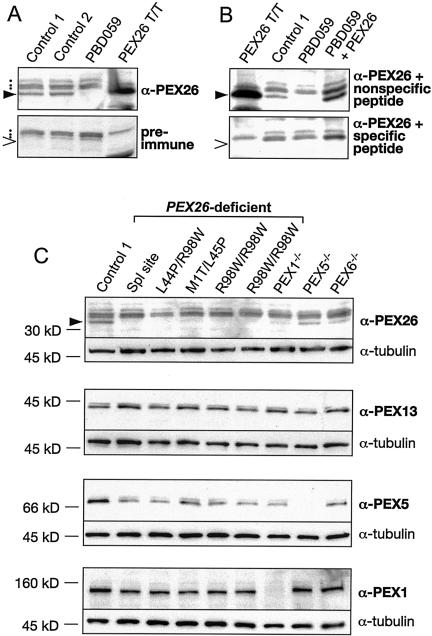Figure 3.
Immunoblot analysis of PEX26 and related peroxins in PBD fibroblasts. All panels show fibroblast lysates (15 μg/lane) or the products of in vitro transcribed and translated full-length PEX26 (PEX26T/T) electrophoresed in 7.5% or 10% polyacrylamide gels, under denaturing conditions, transferred to nylon filters, and detected with the indicated antibody or antiserum. Panels A and B show characterization of our anti-PEX26 N-terminal peptide (NH2-MKSDSSTSAAPLRGLC-COOH) antibody. A, Blots of lysates from control fibroblasts, a PEX26-deficient cell (PBD059, c.230+1G→T/c.230+1G→T), and PEX26T/T detected either with anti-PEX26 (top) or preimmune serum (bottom). The filled wedge (▸) indicates PEX26 (34 kDa), detected only in control fibroblasts and in the PEX26T/T products; the dots indicate nonspecific background bands present in fibroblast lysates; the unfilled wedge (>) indicates the expected location of PEX26 in the preimmune panel. B, Lysates from the indicated sources stained with anti-PEX26 antibody preincubated with either a nonspecific (unrelated) peptide (NH2-QKQEHSGSEEAQKPNC-COOH) (top) or with the specific N-terminal PEX26 peptide used as immunogen (NH2 -MKSDSSTSAAPLRGLC-COOH) (bottom). The lysate designated PBD059+PEX26 is from PEX26-null cells transfected with full-length PEX26. The filled wedge (▸) indicates PEX26 (top); the unfilled wedge (>) indicates expected location of PEX26 (bottom). Note that preincubation with the specific immunizing peptide but not with the unrelated nonspecific peptide completely blocks detection of PEX26. C, Immunoblots of lysates from cells of the indicated genotype stained with anti-PEX26 antiserum and anti-tubulin as a loading control (top panel). The second panel shows the same lysates stained with anti-PEX13 as a measure of the amount of peroxisome membrane in each sample, also with anti-tubulin as a loading control. The third panel shows the same lysate stained with anti-PEX5 and the bottom panel with anti-PEX1. In all panels, the PEX26 genotype is indicated above. The identity and genotypes of the cell lines with mutations in other PEX genes are as follows: PEX1−/−, PBD009 (c.2097insT/IVS18+1G→A) (Reuber et al. 1997); PEX5−/−, PBD005 (R390X/R390X) (Dodt et al. 1995); and PEX6−/−, PBD106 (c.del2398−2417insT/c.1962−1G→A).

